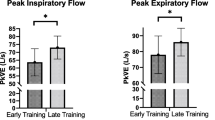Abstract
In ten Thoroughbred racehorses which suffered epistaxis during a race, the mean pulmonary arterial diastolic pressure (PADP) was significantly higher, and the mean pulmonary arterial oxygen tension (PaO2) was significantly lower, than the corresponding mean values of a sample of fourteen clinically normal Thoroughbreds in training.
The authors conclude that in horses with epistaxis during a race, pulmonary dysfunction may persist for up to two months after the episode, and that the results indicate a need for pulmonary function studies before and after racing, in order to resolve problems concerning exercise-induced pulmonary haemorrhage.
Similar content being viewed by others
References
Cook, W.R., 1974. Epistaxis in the racehorse. Equine Veterinary Journal, 6: 45–58.
Hillidge, C.J., 1982. Intrapulmonary distribution of exercise-induced lung haemorrhage in the Thoroughbred racehorse. Proceedings: First International Conference on Equine Exercise Physiology. In press.
Johnson, J.H., Garner, H.E., Hutcheson, D.P. and Merriam, J.G., 1973. Epistaxis. Proceedings: American Association of Equine Practitioners, 19: 115–121.
Littlejohn, A. and Bowles, Felicity, 1980. Studies on the physiopathology of chronic obstructive pulmonary disease in the horse. II. Right heart haemodynamics. Onderstepoort Journal of Veterinary Research, 47: 187–192.
Lettlejohn, A. and Bowles, Felicity, 1981. Studies on the physiopathology of chronic obstructive pulmonary disease in the horse. IV. Blood gas and acid-base values at rest. Onderstepoort Journal of Veterinary Research, 48: 37–45.
O'Callaghan, M.W. and Goulden, B.E., 1982. Radiographic changes in the lungs of horses with exercise-induced epistaxis. New Zealand Veterinary Journal, 30: 117–118.
Pascoe, J.R., Ferraro, G.L., Cannon, J.H., Arthur, R.M. and Wheat, J.D., 1981. Exercise-induced pulmonary hemorrhage in racing Thoroughbreds: a preliminary study. American Journal of Veterinary Research, 42: 703–707.
Raphel, Corinne F. and Soma, L.R., 1982. Exercise-induced pulmonary haemorrhage in Thoroughbreds after racing and breezing. American Journal of Veterinary Research, 43: 1123–1127.
Speirs, V.C., van Veenendaal, J. C., Harrison, I.W., Smyth, G.B., Anderson, G.A., Wilson, D.V. and Gilbo, B., 1982. Pulmonary haemorrhage in standardbred horses after racing. Australian Veterinary Journal, 59: 38–40.
Author information
Authors and Affiliations
Rights and permissions
About this article
Cite this article
Littlejohn, A., Howell, W. & Killeen, V. Pulmonary arterial haemodynamics and blood gas values of Thoroughbred racehorses with a history of epistaxis during a race. Vet Res Commun 8, 41–45 (1984). https://doi.org/10.1007/BF02214693
Accepted:
Issue Date:
DOI: https://doi.org/10.1007/BF02214693




